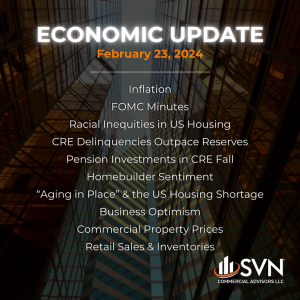- INFLATION

- According to the Bureau of Labor Statistics, the Consumer Price Index rose 0.3% month over month in January and 3.1% annually.
- The monthly pace of CPI rose above market expectations and triggered a brief reversal in equity markets. Fed officials have also been increasingly warning against a premature judgment on the path of its interest rate policy, given the volatility in inflation data and the myriad factors at play.
- The shelter index continued to climb in January, rising 0.6% on the month and contributing more than two-thirds of the monthly increase.
- US energy prices fell -0.9% on the month, bringing the total price change over the previous 12 months to -4.6%. Meanwhile, food prices increased by 0.4% month-over-month in January, driven by both food-at-home and food-away-from-home prices.
- Core-cpi prices, which exclude food and energy, rose 0.4% in January.
- FOMC MINUTES.
- FOMC officials continue to express caution about cutting rates prematurely as the economic picture for 2024 continues to be beset by uncertainties, minutes from their most recent policy meeting show.
- At their January meeting, the FOMC held rates unchanged as they await further inflation and labor market developments. Notably, their post-meeting statement included updated language surrounding the path of rate cuts, with officials reiterating that no cuts would occur until the committee held “greater confidence” that inflation was receding.
- The January tally of CPI justifies the committee’s caution, as price pressures registered higher than markets had expected and initiated a brief price correction in the stock market.
- However, the minutes reflect a general sense of optimism by officials that the policy moves they pursued over the past two years have been successful. Inflation reached a 40-year high in 2022 and has steadily come down since.
- RACIAL INEQUITIES IN US HOUSING
- According to the 2024 Chandan Economics Racial Inequities in US Housing Report, emerging challenges in housing affordability and credit conditions display disproportionate impacts across racial groups.
- Housing affordability indices have fallen precipitously over the past two years, placing further constraints on renter incomes. As of Q4 2022 (the latest data available), 22.5% of all renter households live at or below the poverty line.
- Moreover, constraints show wide variations by racial groups. 37% of Native American or Alaskan Native renter households and 30% of Black renter households fall at or below the poverty line. 25% of Hispanic renter households of all ethnicities and 21.6% of households identifying as multi-racial meet this threshold. The rate falls for White and Asian renter households to 19.9% and 19.4% respectively.
- As borrowing costs and American consumer debt levels rise, credit health and access exhibit similar racial disparities. According to an analysis by Oliver Wyman, on average, 45% of Americans receive prime credit rates. When measured by race, 62% of Asian Americans, 51% of White Americans, 29% of Hispanic Americans, 24% of Americans of other racial groups, and 20% of Black Americans receive prime credit rates.
- CRE DELINQUENCIES OUTPACE RESERVES
- A recent analysis by the Financial Times reports that the level of delinquent commercial real estate debt held by the largest big banks surpassed their total bank reserves in 2023, raising concerns about the financial system’s exposure to emerging risks.
- Utilizing data from the FDIC, the report found that the average reserves at the nation’s largest six banks have fallen from $1.60 to 90 cents for every dollar of CRE debt on which a borrower is at least 30 days late.
- Bank reserves are used to buffer against potential loan losses, and as real estate valuations fall alongside rising interest rates, pressure on reserves has increased.
- Still, it is essential to note that delinquencies don’t mean defaults, and the immediate concern for regulators is the banks’ exposure to potential risks rather than a judgment of loan conditions.
- Last year, the Federal Reserve’s supervisory functions refocused efforts toward banks and their exposure to interest rate and CRE risk following a string of bank failures during the first half of the year. Officials have increased the issuance of enforcement actions and downgrades in an effort to deter complacency.
- PENSION INVESTMENTS IN CRE FALL
- A report by Ferguson Partners details how investment pledges to commercial real estate funding vehicles from US pensions fell by 50% in 2023 to its lowest commitment level in a decade.
- Momentum began to slow during the second half of 2023, while the 2023 average fell 25% below the average volume of the last ten years. Analysts from Ferguson call the development a “stark recalibration” from the upward trend seen over the previous five years.
- Industrial property funds attracted the largest share of CRE pledges (35%), followed by those targeting data centers, life sciences, and SFR (33%), and multifamily (27%).
- HOMEBUILDER SENTIMENT
- According to the National Association of Home Builders, builder sentiment improved for a third consecutive month in January as construction firms expect mortgage rates to continue to moderate from last year’s levels.
- The prospect of a Fed pivot to rate cuts in 2024, alongside a lingering lack of housing supply, suggests that all else equal, building activity should improve in the coming months. However, in recent days, higher than expected inflation data and cautionary signals by Fed officials have pushed markets to reconsider their rate-cut expectations for 2024.
- NAHB forecasters project that at current conditions, any Fed-rate cut would likely come in the latter half of 2024, which would send single-family starts up by 5% compared to 2023, based on their forecasting.
- NAHB Economists note, however, that as building activity rises, lot availability and a shortage of skilled labor will become a growing concern.
- “AGING IN PLACE” AND THE US HOUSING SHORTAGE
- A new analysis by Redfin shows that an increasing number of older Americans are “aging in place,” meaning they increasingly remain in their established homes rather than downsizing or moving to senior communities. The trend may complicate an already stubborn US housing shortage.
- The average US homeowner of all ages has spent 11.9 years in their home, almost double the average of 6.5 years two decades ago.
- Tenure peaked in 2020 as the pandemic homebuying boom induced a moderate decline in the rate. However, much of this downtrend was driven by millennials buying their first homes or being more inclined to initiate a life change.
- Meanwhile, baby boomers continue to stay in their homes for longer. As homebuying cools relative to pandemic-era highs, the trend in tenure may again inflect.
- Part of the reason behind the trend is financial. Most baby boomers own their homes free and clear, and longer-tenured owners bought mortgages at much lower rates than today’s generationally high rates. Further, some states retain tax incentives for older homeowners, including two of the most populated— Texas and California.
- Non-financial reasons, including generational views on assisted living and advancements in medical and tech, have also recalibrated senior housing demand.
- BUSINESS OPTIMISM
- According to the National Federation of Independent Businesses (NFIB), small businesses grew more pessimistic in January, with the index tracked by NFIB falling to 89.9, its lowest level in eight months.
- Labor quality and inflation remained the top concerns for business owners. 21% of owners reported labor quality as their single most important problem in operating their business, while 20% cited inflation as their top problem.
- Interestingly, as a sign of improving hiring conditions, the share of owners reporting job openings they can not fill fell to 39%, the lowest reading since January 2021.
- However, hiring plans are also at a post-pandemic low. Only 14% of owners intend to create new positions within the next three months, down two percentage points from December and its lowest since May 2020.
- COMMERCIAL PROPERTY PRICES
- According to the MSCI-RCA commercial property price index (CPPI), the decline in US commercial sector prices slowed further to start 2024.
- Prices fell 4.7% year-over-year through January but just 0.1% from December. For context, the commercial sector saw annual price declines of around 11% during the summer of 2023.
- The industrial sector again arose as the only property type with an annual increase in January. The average price on an Industrial property climbed 1.2% month-over-month from December and 1.3% over the past 12 months. The Industrial sector has experienced consecutive monthly price increases since June 2023.
- Apartment sector prices declined 7.9% year-over-year, an improvement over the past several months as markets increasingly expect a Fed policy pivot on the horizon. Apartment price declines peaked in August of last year when they fell at an annual rate of 14.1%.
- Retail joined Industrial as the only sectors to post monthly price increases in January. Retail sector prices rose 0.1% from December following a -0.1 decline in the previous month. Sector prices fell -3.6% year over year, an improvement over December’s -5.5% and the sixth consecutive month of improvement.
- Suburban office prices fell -11.9% year-over-year and -0.4% month-over-month. Meanwhile, CBD office valuations fell -28.9% annually but saw its rate of monthly decline slow to just -1.0%. The differing magnitudes of devaluation largely reflect each sub-type’s sensitivity to remote work. Simply put, the negative demand shock appears most intense in dense, high-price office markets.
- RETAIL SALES & INVENTORIES
- According to data from the US Census Bureau, US retail sales rose 0.6% year-over-year in January, the slowest pace of annual growth since the onset of the COVID-19 pandemic. Sales were down 0.8% from December.
- While sales growth has come back down to earth after achieving a record high of 52.0% year-over-year in April 2021, the industry appeared to hit a nadir of 1.29% in April 2023 and has grown steadily since then. January’s 0.6% annual mark challenges this trend and is a steep drop from the 5.31% charted in December.
- A seasonal pull-back in activity is expected during January and February as the holiday boom in sales cools off.
- Automobiles and vehicle parts continue to outperform the broader retail market. Excluding autos, US retail sales declined 0.6% month-over-month in January and climbed 1.2% year-over-year.
- directional movement in sentiment than non-investors.
SUMMARY OF SOURCES
(1) https://www.bls.gov/news.release/cpi.nr0.htm
(2) https://www.federalreserve.gov/newsevents/pressreleases/monetary20240221a.htm
(3) https://www.chandan.com/_files/ugd/df56fe_07f73f4b0a054d35b4d578e36afda4f7. pdf?index=true&utm_campaign=4cd7dbe2-1a0a-4402-80e8-02dc3fc1ac51&utm_source=so&utm_ medium=mail
(4) https://www.ft.com/content/4114454c-a924-4929-85f4-5360b2b871c6
(5) https://www.globest.com/2024/02/21/cre-pledges-from-us-pensions-drop-50/
(6) https://www.nahb.org/news-and-economics/press-releases/2024/02/builder-sentiment-poststhird-consecutive-monthly-gain
(7) https://www.redfin.com/news/homeowner-tenure-2023/
(8) https://www.nfib.com/
(9) https://info.msci.com/l/36252/2024-02-21/y1htr4/36252/1708559067qvvmBG37/2402_RCACPPI_ US.pdf
(10) https://www.census.gov/retail/marts/www/marts_current.pdfx

